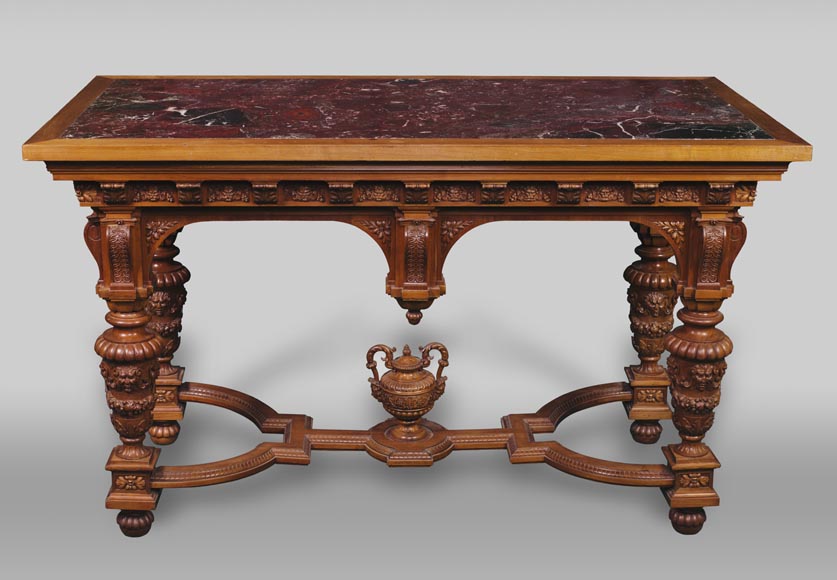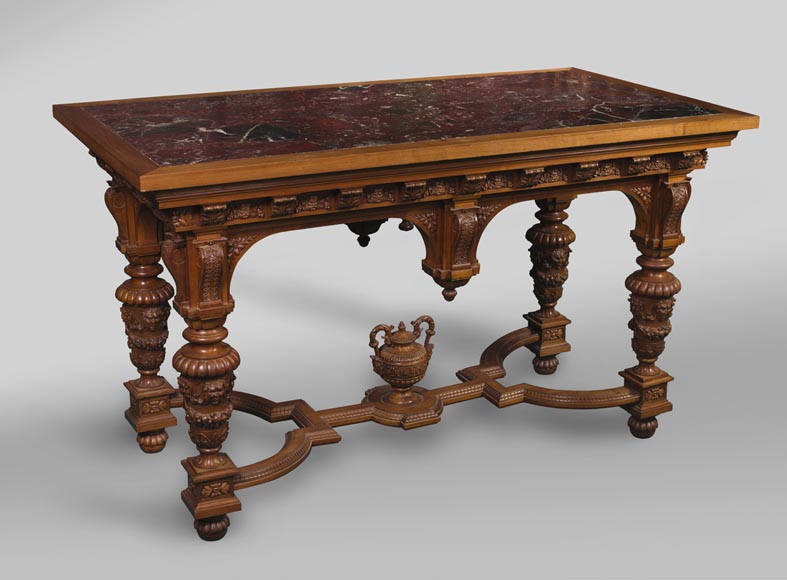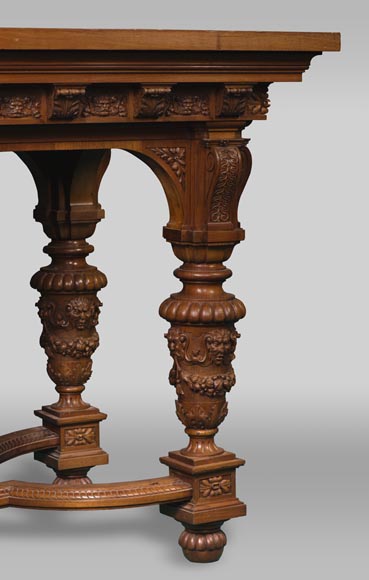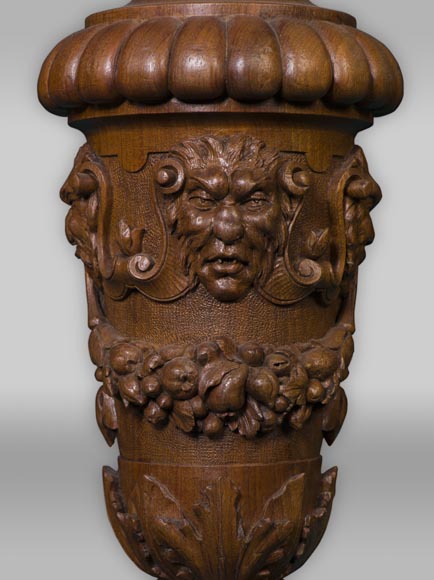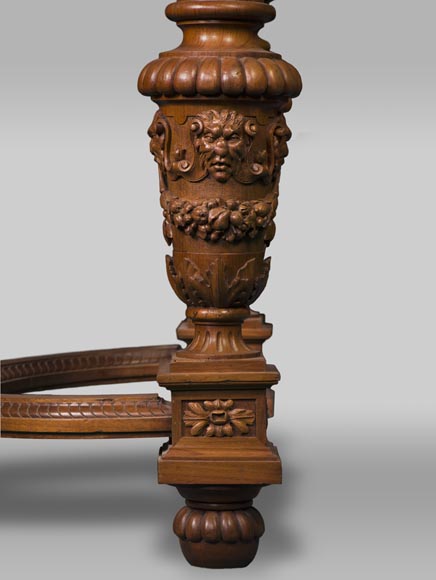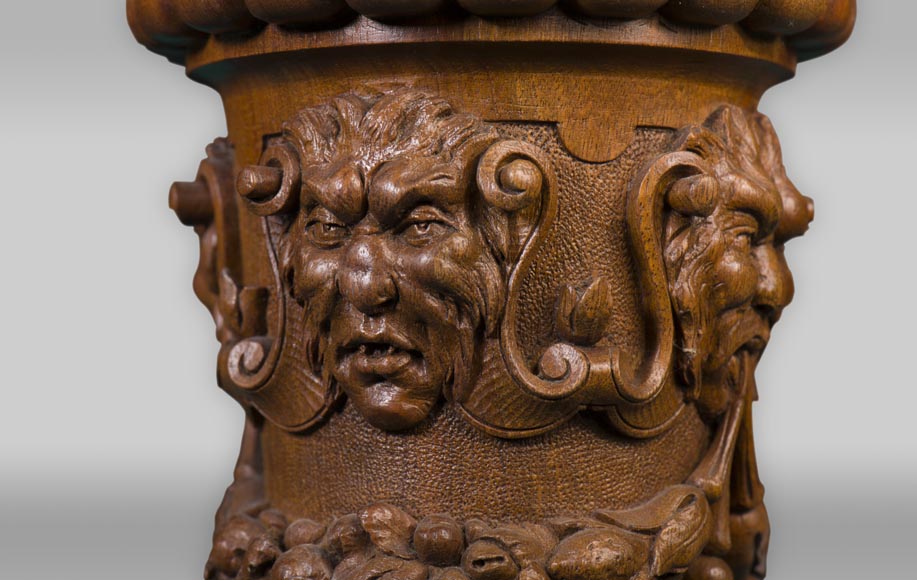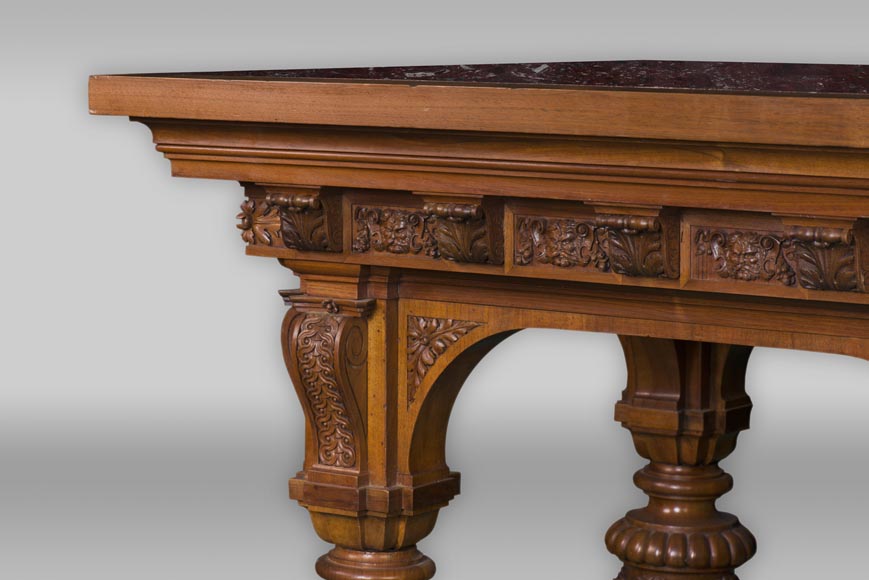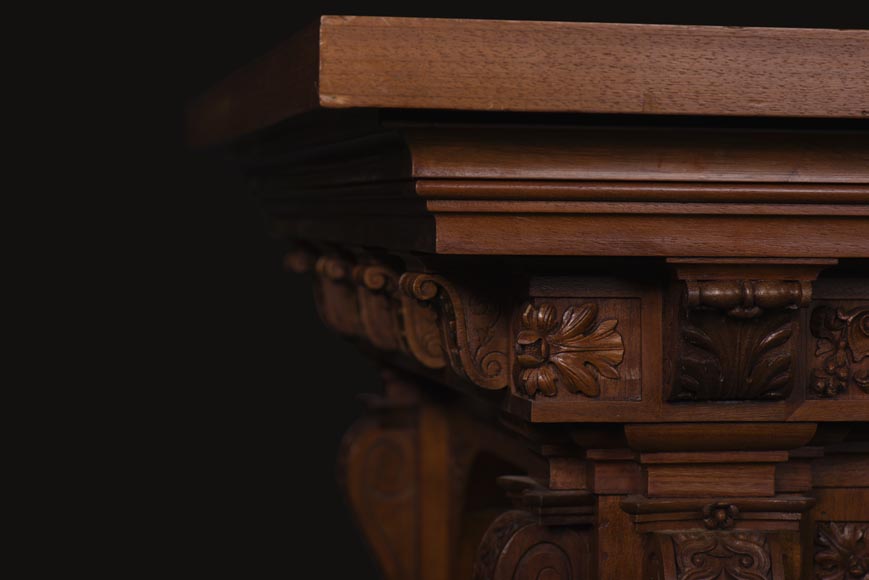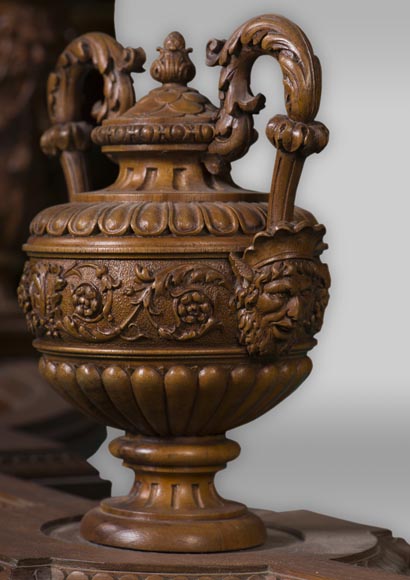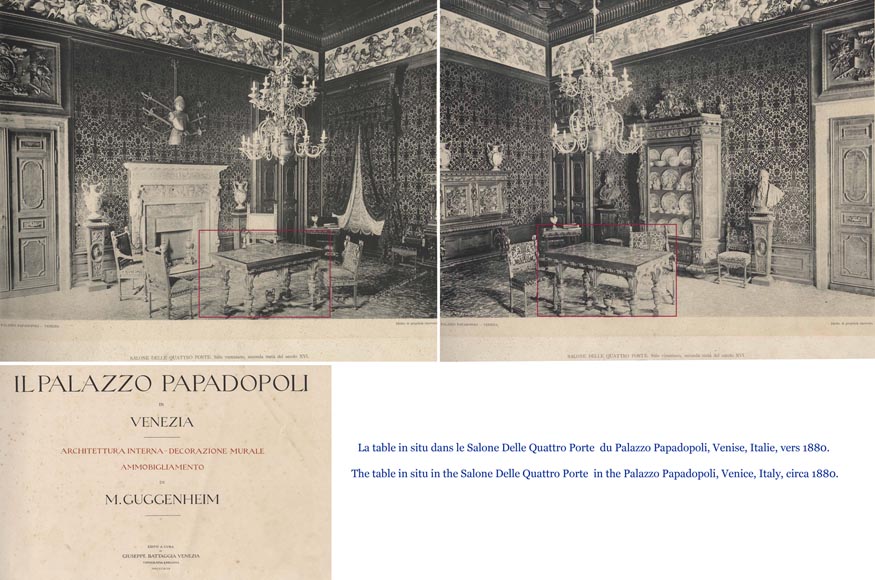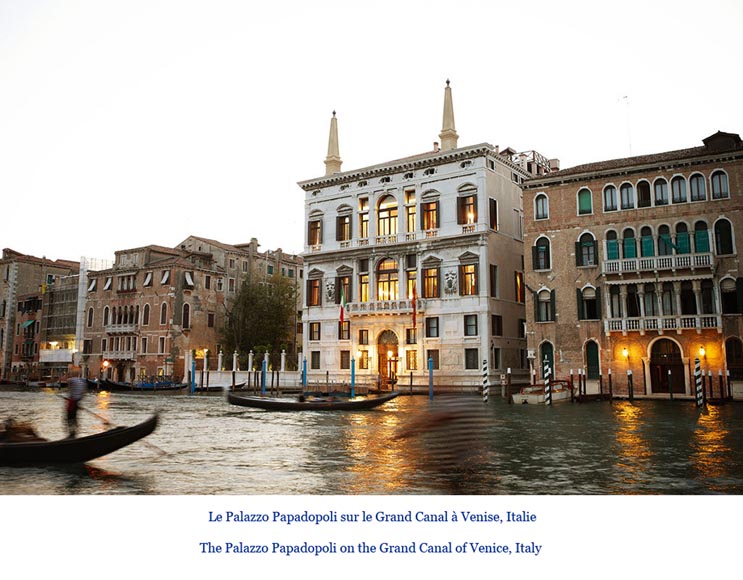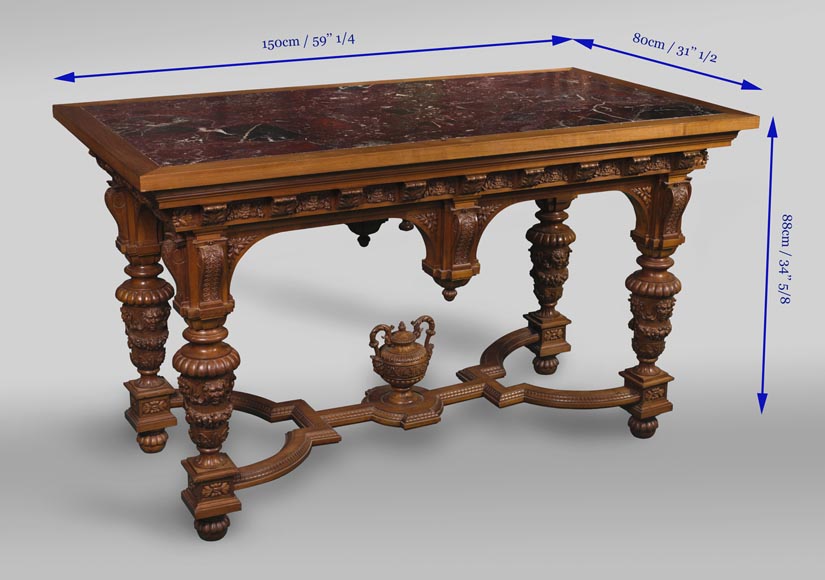Style Neo-Renaissance / Ref.03165
The table coming from an exceptional furniture set realized by Moses Michelangelo Guggenheim for the Palazzo Papadopoli in Venice, Italy
Dimensions
Width 59'' 150cm
Height 34'' ⅝ 88cm
Depth: 31'' ½ 80cm
Origin:
Between 1874 and 1881.
Salone delle Quattro Porte, Palazzo Papadopoli, Venice, Italy.
Status:
Sculpted walnut wood and Levanto Rosso marble.
In excellent condition.
Also presented in the Salone delle Quattro Porte, this table was made in the same style as the other pieces, that is to say respecting the style of sixteenth century Venice. Also presented in the Salone delle Quattro Porte, this table was made in the same style as the other pieces, that is to say respecting the style of sixteenth century Venice. It is made of carved wood and the shelf, in marble, is embedded in the wood, considerably enriching the whole.
Again, this is a real showpiece for the quality and fineness of the sculpture. All four legs are connected by a X-shaped spacer whose center shows the representation of a kind of amphora with a lid in encrusted enamel. The pedestal, delicately fluted, echoes the lower part of the body of the vase that is fluted. Below, a frieze of interlaced foliage is set against a texturized background. This background, produced thanks to a special hammer with small spikes called a bush hammer, does not catch the light in the same way as the smoother parts of the wood. In this way one can perceive the extreme attention given to this sculpture. The vase is topped by a cover whose primary element is a blooming flower. The cover is in turn covered with scales. The handles, in their upper parts appear to be true plants. In the lower bracket, they are of masks of men who take their place. The four feet balusters are also a very nice quality. Based on a round foot, their central part is represented by a kind of vase mounted on a pedestal. These elements are delicately carved with festoons and monsters: Pan heads are connected by interlaced ribbons. Again, the bottom is textured, keeping the attention and the light on the carved elements on the smooth surface. The four feet are completed in their upper part by elements winding on themselves and carved with interlacing. The shelf rests on corbels, an architectural element that is normally used to support the cornices. The modillion differs from the corbel because it is a sculpted part, as we see in this table. Here they are covered with acanthus leaves ending in a coil. On the recesses, the masks of bearded men are displayed on winding leather motifs.
The Palazzo Papadopoli is a Venetian palace built by Giovanni Giacomo de Grigi (active from 1540 to 1575), around 1560. Facing the palace Sanmicheli on the Grand Canal, it was built for the family Coccina, originally from Bergamo. The façade overlooking the Grand Canal is decorated in the center with Palladian loggias resembling those of the architect Michele Sanmicheli (1484 - 1559), Mannerist architect of the Verona school. On the sides, simple windows with triangular pediments and curves are strongly influenced by the architecture of Andrea Palladio (1508-1580). Under the cornice appear small oval openings with frames characteristic of Jacopo Sansovino (1486-1570). The palace is surmounted by two obelisks, symbols of the Capitani da Mar.
After the disappearance of the last Coccina family member in 1748, the palace was bought by the Tiepolo. Subsequently, the palace passed from hand to hand before being purchased on January 25, 1864 by two brothers, Nicolo and Angelo-Papadopoli Aldobrandini, descendants of a family from Corfu who came to settle in Venice. Landowners, bankers, industrialists, parliamentarians and numismatists, the brothers Aldobrandini-Papadopoli were typical representatives of the rich upper class of Venice in the nineteenth century. Thus began the last phase of splendor of the palace which was considerably enlarged and whose surroundings were redecorated entirely from 1874-1875. This undertaking was led by the architect Girolamo Levi and by the decorator and antique dealer Michelangelo Guggenheim. The first step was the work of expansion and modernization of the palace, the second interior decoration, following an eclectic style. The renovation was so important that a columnist wrote, in the "Gazzetta di Venezia": "The Palace Tiepolo of the sixteenth century gives birth to the Palace Papadopoli of the nineteenth century. "The funiture set that we present here is a sumptuous testimony to the work of Stabilimento Arti Decorative e Industriali, which knew how to exquisitely respond to an order of prestige. The presentation of this set is a great rediscovery of the history of Italian art of the second half of the nineteenth century, especially for an artist who was very famous in Venice at that time and that the twentieth century has unfortunately forgotten. Yet the works of Michelangelo Guggenheim are of a rarely equalled quality, reaching the height of decorative art of the nineteenth century. He uses his extensive knowledge of past styles, here, the Venetian sixteenth century. All these pieces were conceived as a whole, a sum of elements that were dedicated to reviving an aristocratic Venetian home of the late Renaissance.
This set of 14 pieces of furniture coming from the Palazzo Papadopoli will be sold as one set.
Informations
Price: on request
Recommended for you :
Dimensions:
Width: 138
Height: 77
Depth: 85
Dimensions:
Width: 85
Height: 82
Depth: 57
Dimensions:
Width: 230
Height: 262
Depth: 66
Dimensions:
Width: 140
Height: 79
Depth: 136
Dimensions:
Width: 123
Height: 76
Depth: 72
Dimensions:
Width: 171
Height: 77
Depth: 94
Dimensions:
Width: 126
Height: 74
Depth: 36
Dimensions:
Width: 303
Height: 76
Depth: 115
Dimensions:
Width: 159
Height: 80
Depth: 98
Dimensions:
Width: 72
Height: 76
Depth: 105



